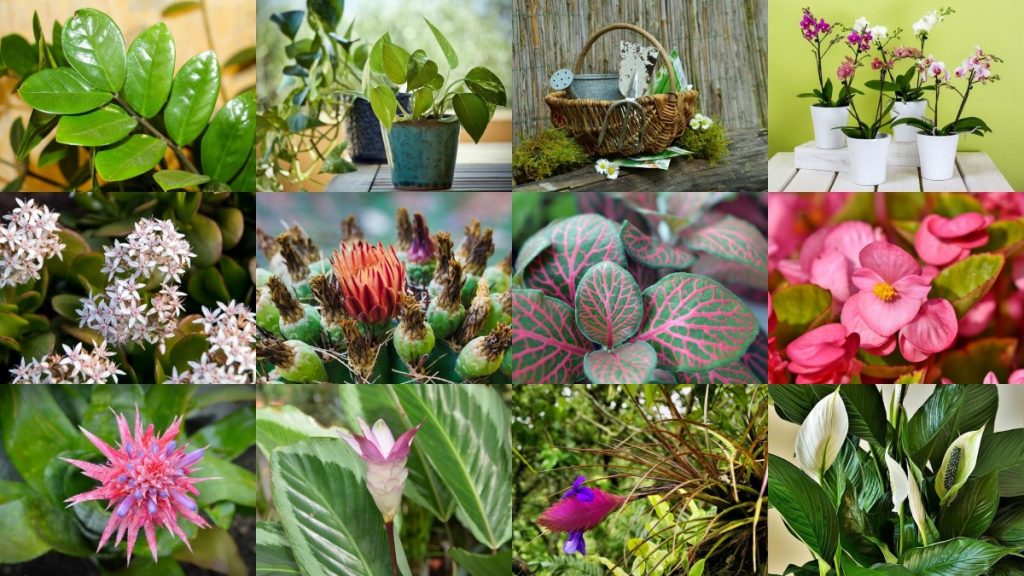Plants have a strong positive impact on the well-being of humans. They provide the oxygen we breathe and they have a psychological effect that makes us become calmer and more relaxed. Admit it or not, we appreciate plants one way or another and since we spend most of our time indoors, bringing plants into our home and offices helps us have a closer connection with nature.
- Common Types of Indoor Plants You Can Grow Easily
- 1. Adiantum sp.
- 2. Aechmea spp.
- 3. Aglaonema
- 4. Aloe vera
- 5. Anthurium spp.
- 6. Begonia
- 7. Calathea
- 8. Chamaedorea Seifrizii
- 9. Chlorophytum comosum
- 10. Chrysalidocarpus lutescens
- 11. Crassula ovata
- 12. Dieffenbachia
- 13. Dracaena fragrans
- 14. Dracaena marginata
- 15. Epipremnum aureum
- 16. Ferocactus spp.
- 17. Ficus benjamina
- 18. Ficus elastica
- 19. Ficus lyrata
- 20. Fittonia
- 21. Monstera adansonii
- 22. Monstera deliciosa
- 23. Nephrolepis exaltata
- 24. Oxalis triangularis
- 25. Phalaenopsis
- 26. Philodendron selloum
- 27. Rhapis excelsa
- 28. Saintpaulia
- 29. Sansevieria trifasciata
- 30. Sedum morganianum
- 31. Senecio rowleyanus
- 32. Spathiphyllum
- 33. Thiudium, Fern moss
- 34. Tillandsia
- 35. Zamioculcas zamiifolia
- 36. Aphelandra squarrosa
- Indoor Plant Requirements
- Tools and Materials
- FAQs
The best indoor plants not only bring us closer to nature, but they also make our homes more attractive and relaxing. Aside from this, plants obviously turn carbon dioxide into oxygen and they purify the air we breathe as well. Many indoor plants are capable of trapping and absorbing pollutants from the many items and appliances we have at home and in the office (1).
In this guide, we created a list of the best houseplants to help you get started on your journey to creating a successful indoor garden. We also have identified the basic requirements in choosing and caring for your indoor plants.
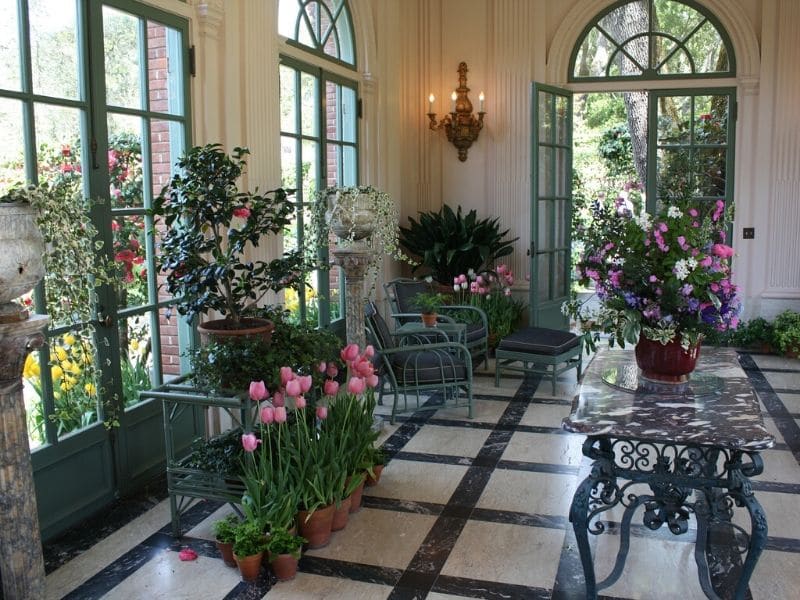
Common Types of Indoor Plants You Can Grow Easily
1. Adiantum sp.
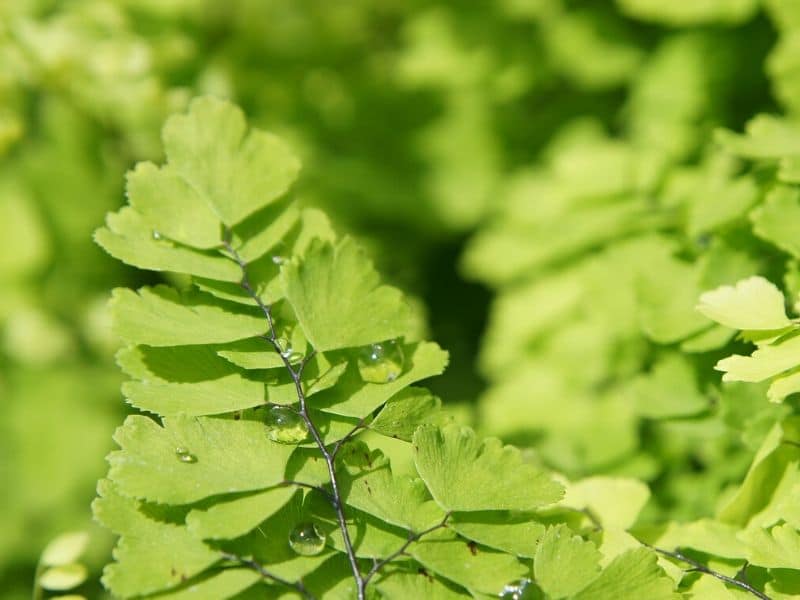
Adiantum or maidenhair fern is a decorative ornamental plant originally found in tropical rainforest areas where the condition is moist and the light is filtered. It showcases attractive small thin evergreen leaves and black spindly stems. These environmental and physical characteristics make the plant a suitable and popular indoor plant (3).
Maidenhair fern can be potted or planted in hanging baskets. Placing it by the window facing east or west is ideal so that it can receive mild morning and evening sun. Harsh light damages the leaves and turns them brown. Also, make sure to keep the soil moist but not waterlogged.
2. Aechmea spp.
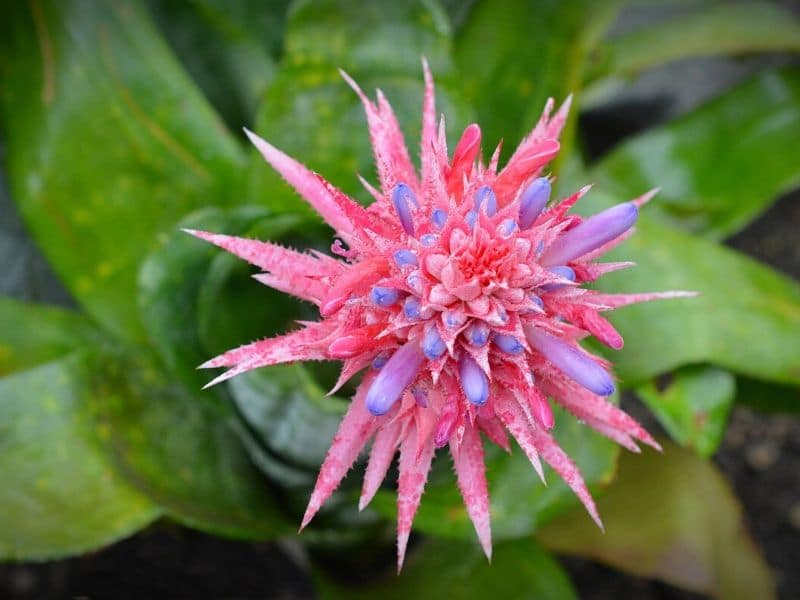
Aechmea is a genus of bromeliads known for the rosette of large spiny foliage in a variety of colors. One of the most common species, A. fasciata or urn plant, is green with a silver horizontal stripe-like pattern.
Urn plant produces a long-lasting pink flower spike that bears tiny purple flowers from the bracts (4).
This bromeliad is epiphytic or grows non-parasitically on trees. The root system is shallow and when potted, only requires half a foot-sized container. It does not have a stem so it takes in water through the storage in the middle of the rosette called tank.
For indoor aechmea, this tank should be emptied from time to time and re-filled with distilled or rainwater to avoid pests and infections.
3. Aglaonema
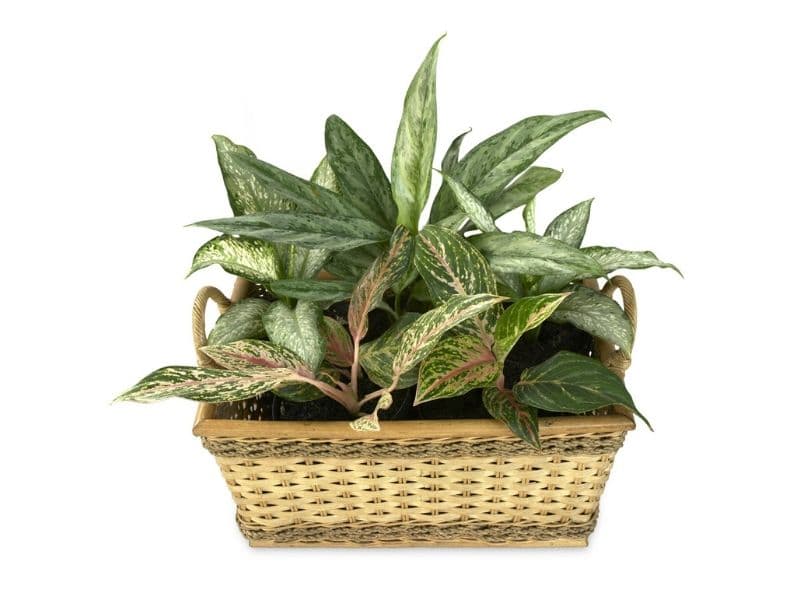
The Aroid plant family houses diverse and versatile plants used indoors. One of them is Aglaonema commonly known as Chinese evergreen (4). The Chinese were the first to cultivate the dark green plant, hence the name but nowadays, hybrids exist in several colors and they are mostly referred to with their various names.
Generally, Aglaonemas have broad spade-like green leaves with mottled or brushstroke-like patterns in a lighter or darker shade. Some varieties come in yellow, red or pink shades too.
Aglaonemas are successful house plants because, like most aroids, they naturally grow in dark tropical forest areas so they easily adapt to the light available indoors. Popular varieties include ‘Silver Queen’, ‘Cecelia’, ‘Doña Carmen’ and ‘Queen of Siam’.
4. Aloe vera

Aside from its importance in cosmetic and medicinal industries, Aloe vera is also treated as an ornamental plant and is popularly grown indoors. Its form is attractive and it thrives with less care under the right conditions. This succulent is stemless and grows a fan of thick fleshy speckled green leaves with serration on the margins (5).
Aloe vera grows fast outdoors and slower as a houseplant so it makes a good potted plant, taking less space and maintenance. Since it can store moisture in its fleshy leaves, it can withstand drought. Aloe vera will need to be placed in a room where there is lots of light, may it be natural or artificial, to avoid leggy growth.
5. Anthurium spp.
Anthurium is among the few long-blooming plants that grow perfectly under shaded conditions which also makes it a reliable indoor plant. The shiny heart-shaped dark green foliage is enough to grab anyone’s attention but the bright red, sometimes white, yellow, orange, or purple, flowers make the plant stand out even more (3).
Anthurium will grow in your poorly lit rooms but indirect sunlight is best to keep it flowering. Slow-release complete fertilizers will also improve blooming frequency but are not as essential to the plant’s growth.
Make sure that the potting medium is well-draining to keep it moist and not saturated. A mixture of perlite, coco coir dust, and loamy soil works well for this plant.
6. Begonia

Considered as a traditional houseplant, begonia has been a staple in our grandmothers’ collection of plants. There are over 1000 species of its kind that come with showy foliage and vibrant flowers. They are mostly known for their broad and waxy leaves and multi-petaled flowers in shades of yellow, white, orange, pink, red, and purple.
There are different types of begonia but all of them require a bright location but not direct sunlight. Begonias grown for their foliage will tolerate poorly lit conditions while the flowering kind prefers brighter medium light. As for watering, they all like moist potting soil but poor draining soil that causes water-logging leads to rotting of roots and decay of the plant (5).
7. Calathea

Grown for its striking, often patterned foliage, Calathea has become a popular indoor plant. Different species and varieties showcase broad leaves that often have striped leaves in shades of white, green, and purple with undersides in striking colors as well. Their foliage is dramatic and gives an instant refreshing appeal indoors.
Calathea is commonly called a prayer plant because the leaves that are spread and open during the day close at night, looking like praying hands. It likes a room that receives moderate indirect sunlight. To keep the spread of the plant even at all angles, make sure to rotate the position from time to time. Water only when the top inch of soil feels dry (5).
8. Chamaedorea Seifrizii
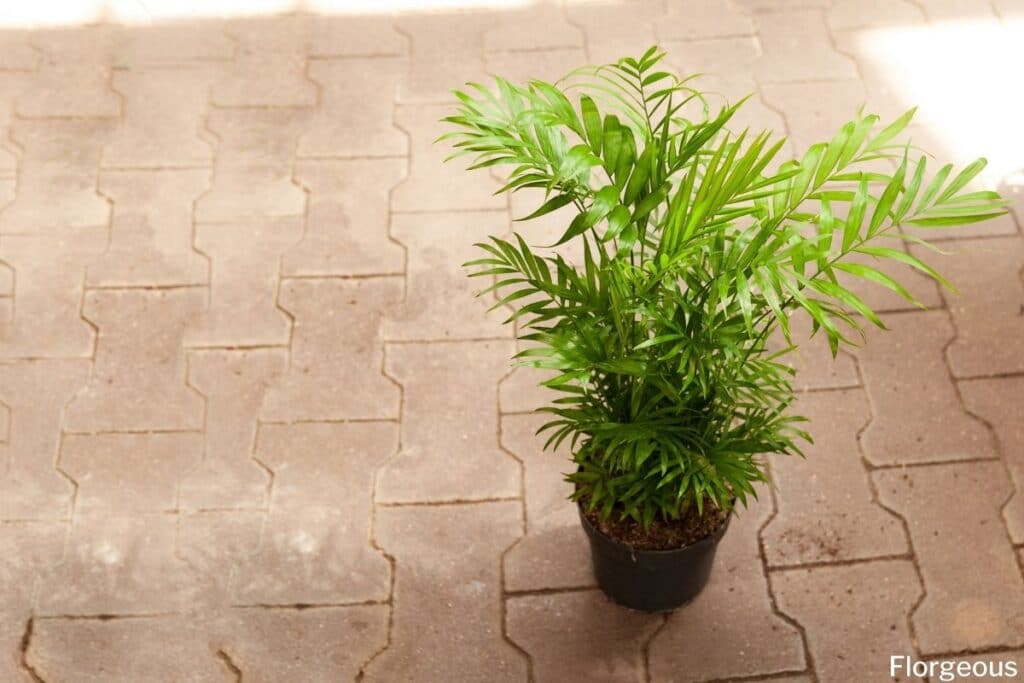
Otherwise known as bamboo palms, this plant has slender ringed dark green trunks that look like bamboo stems. The feather-like fronds are airy and look elegant against painted walls indoors.
It is a decorative houseplant that likes partial shade so placing them in rooms with poor lighting does the plant a favor. Let it soak under filtered sunlight every once in a while to keep the plant healthy (1). Like the areca palm, seifrizii is also a known air purifier, able to remove indoor air toxins like benzene and formaldehyde.
9. Chlorophytum comosum
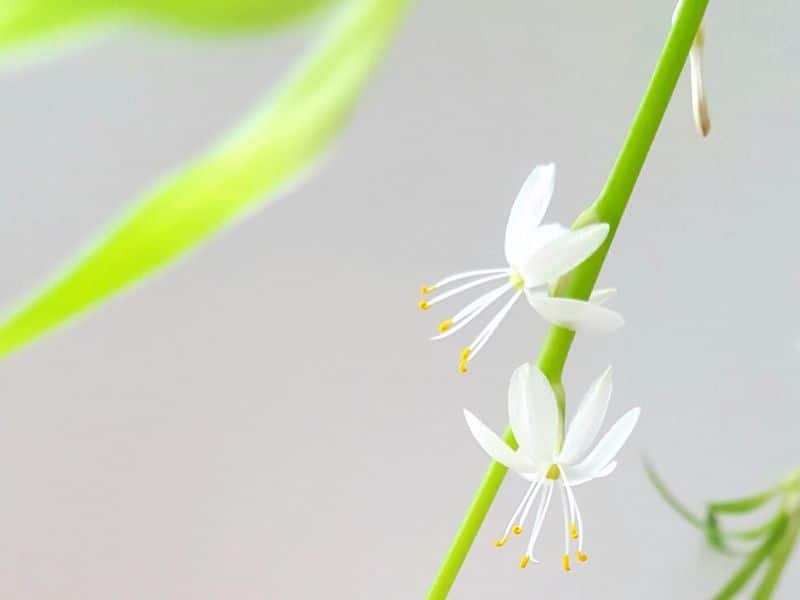
Commonly known as spider plant, this decorative plant has long thin pointed green leaves, sometimes with white stripes. It grows fast and has a dense fountain-like growth habit. It produces spindly stems where new plantlets (plant babies) grow giving it a spidery appearance from which the common name was derived (1).
10. Chrysalidocarpus lutescens
While the areca palm, also known as the butterfly palm or simply “areca,” is cherished for its decorative value and adaptability to indoor environments, it’s its air-purifying qualities that truly elevate it to best indoor plant contender. This effect made it popular in the early 1900s.
In a series of air cleaning experiments by NASA in the 1980s, they tested the ability of 50 plants to filter the air in the indoor setting. They found that areca palm is the most effective in cleaning the air and this further popularized the use of the plant indoors, especially in offices (1).
11. Crassula ovata
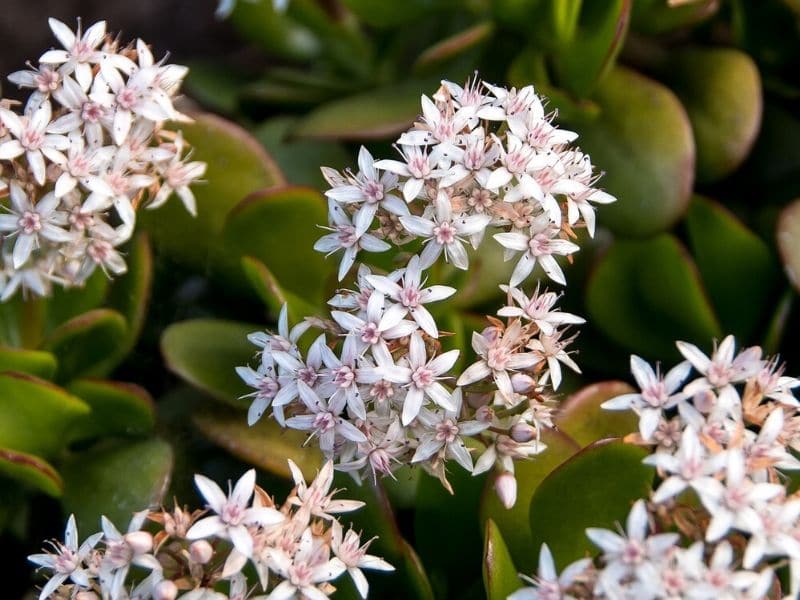
This succulent is popularly grown as an indoor plant because many people, especially the Chinese believe that it brings good fortune, hence the common name money plant. It is known for its thick fleshy stems and egg-shaped leaves. These parts store a good amount of moisture so the plant does not require frequent watering (4).
Jade plants are normally green-leafed but many varieties have a reddish tinge. Plants grown indoors rarely produce flowers but when they do, they produce a delightful sight of tiny white or pinkish florets with five open petals and five semi-closed ones bearing the stigma and anthers.
This plant is fairly easy to grow. It survives in all kinds of light conditions but still grows best in well-lit areas. The watering requirement is also not strict, as long as the soil is kept moist but not waterlogged. It grows well in pots and containers but the architectural effect of the plant form is better appreciated when grown in hanging baskets.
12. Dieffenbachia
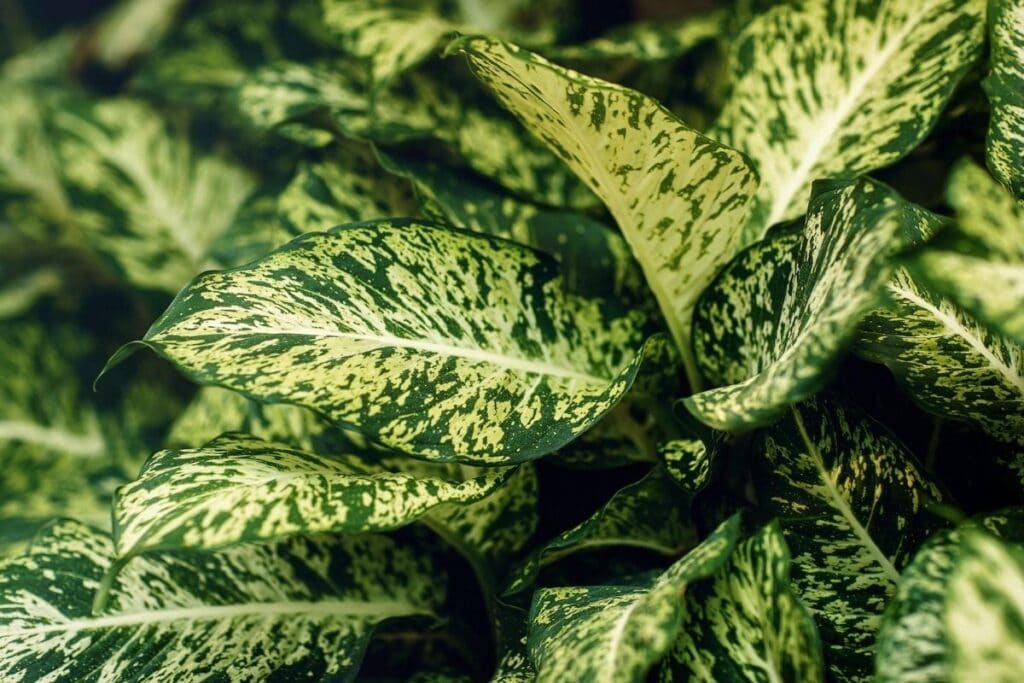
Dieffenbachia is an old-fashioned ornamental plant cultivated for its large showy foliage in a mixture of shades of green, yellow, and white.
The leaves are definitely decorative and bring life into a room. However, studies show that the plant can be toxic to humans and animals when ingested.
There are microscopic needle-like structures in all parts of the plant that cause swelling and pain in the mouth and throat. This renders the victim unable to talk, hence the plant’s common name dumb cane. Dieffenbachia is an effective indoor plant because it grows well indoors, just make sure to place it in a room not accessible to kids and pets (4).
Read more: Dieffenbachia Varieties and Types of Dumb Cane Plants to
13. Dracaena fragrans
A plant considered lucky by the Chinese, D. fragrans has been grown indoors since the 1800s and is often called fortune plant. Another name is corn plant due to the long sword-like drooping leaves that resemble those of corns. Its popularity as a houseplant grew because of the attractive two-toned leaves, narrow and controlled growth, and undemanding growth habit (4).
Fortune plant can tolerate partly shaded areas but grows best under bright light even if it was from an artificial source. The soil should not be kept dry but avoid overwatering as this will cause leaf tip burn. In its natural habitat, temperature and humidity tend to be high so bring the plant outside from time to time, especially in summer.
14. Dracaena marginata
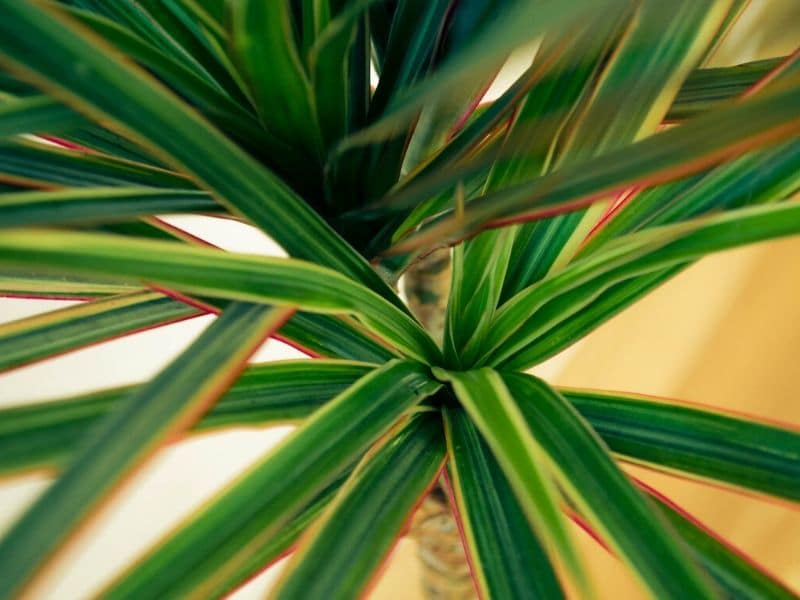
Also known as dragon tree, this dracaena species makes a good house plant because of the elegant form and decorative leaves. It’s one of the best low maintenance houseplants every beginner should own. Its leaves are thinner and more upright and compact but the growth requirements are the same as with fortune plant (4).
Like most dracaenas, dragon trees are easy to propagate and grow. The plant is usually single-stemmed and to promote branching, the topmost part is cut. In a week or two, new shoots will grow from the active nodes of the plant.
15. Epipremnum aureum

One of the easiest house plants to keep, E. aureum or golden pothos is preferred by beginning indoor plant parents. Its heart-shaped foliage on vine-like stems is remarkable and it can be allowed to grow on a pot or hung when the elongating stems start to overflow (5).
Propagating pothos plant is refreshingly easy too since you only need to cut the end of the stem with signs of new roots, dip it in water-filled glass, and watch it grow on its own! Just note that despite its ability to form a new root system while submerged in water does not apply to potted ones. Waterlogging potted pothos will lead to root rot and possible bacterial and fungal infections.
See more: indoor climbing plants
16. Ferocactus spp.
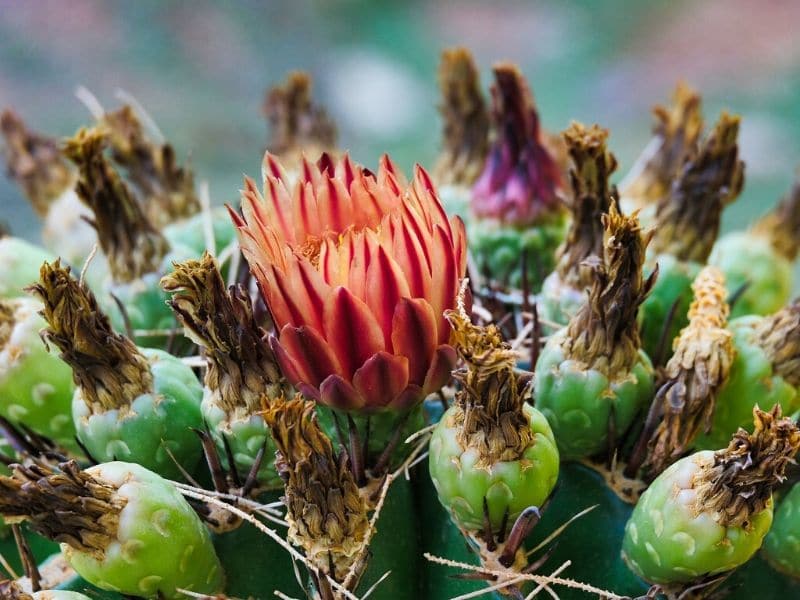
Ferocactus derived its name from the Greek words fierce and thistle but it is more commonly known as barrel cactus because of the familiar shape. It is one of the most popular ornamental cacti adored for its form and ease of maintenance. Barrel cactus grows slowly so indoors, it can be planted in small containers. It can reach up to 10 feet in height in the wild.
As with other cacti, the indoor setting must be well lit, better if there is harsh direct sunlight. It naturally grows in desert landscapes and is extremely tolerant of drought. Indoor watering should be minimal, a thorough watering every 2 to 3 months is enough.
17. Ficus benjamina

Commonly called weeping fig, this plant is popularly grown indoors to bring a tree from inside the house or the office. The plant grows big outdoors but the growth is more controlled when potted. It bears a canopy of glossy teardrop-like green leaves with new leaves in a lighter shade. The light gray stem or trunk is also made more attractive when braided.
Weeping fig is tolerant of indoor conditions which makes it a successful houseplant. It can grow under dark areas and low water supply but it will experience stress in extreme conditions. A common sign of stress for many ficus plants is leaf drop so watch out for this (3).
See more: Ficus Bonsai Trees
18. Ficus elastica
More commonly known as rubber tree because its sap is the source of rubber, this ficus has grown popular as a houseplant. It makes an excellent focal point indoors with its handsome glossy leaves. They are usually green in color but hybrids today come in burgundy and variegation of yellow and white.
With the right water and light conditions, rubber trees will thrive inside your home. Bring them outside every once in a while to allow the plant to breathe and recover (3). It can also accumulate dust indoors so make sure to wipe off any dirt on the leaves.
19. Ficus lyrata
What makes F. lyrata or fiddle-leaf fig a striking house plant is its large glossy oval-shaped leaves often clumped atop a slender trunk or stem. It has become more popular in the past few years because of its minimalistic and modern appeal, being featured on social media and design publications.
However, growing fiddle-leaf fig indoors can be a bit tricky. Ficus trees grow best outdoors where there is natural sunlight and in the ground where they can establish a good root system. Some ficus trees can be trained as bonsai trees.
The indoors will cause stress and may even make them lose their leaves so make sure that they will receive bright and even indirect sunlight. Be cautious about irrigation as well and only water when the soil is dry (3).
20. Fittonia
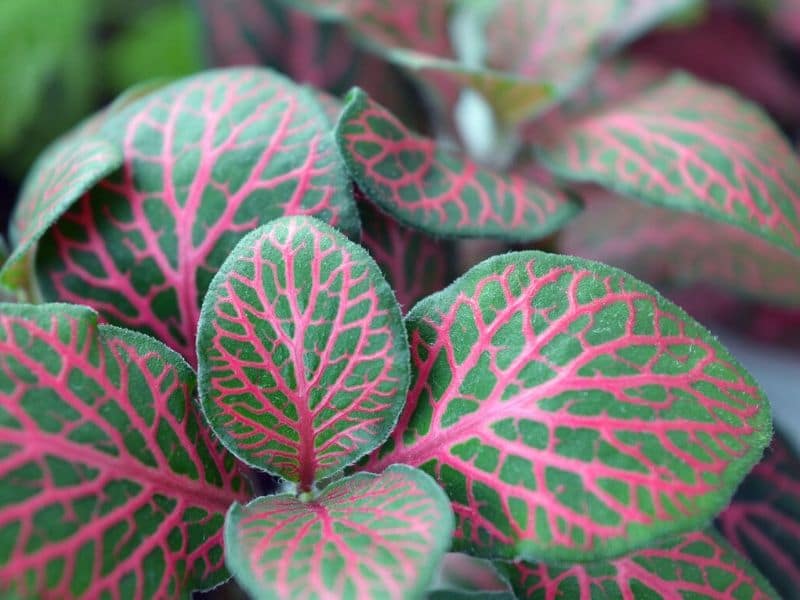
Fittonia is also called nerve plant owing to the prominent nerves or venations on the leaves. The plant is small, usually reaching up to a foot high. This plant is becoming more popular for indoor growing because of its attractive foliage. The leaves are either green and pink or green and white and they grow compact, perfect on small containers.
Nerve plants can also be grown in hanging baskets and terrariums. They like a humid condition, moderate watering, and filtered sunlight. Propagation to make new plants is made through cuttings and this will also promote lateral growth, making the plant more compact (3).
21. Monstera adansonii
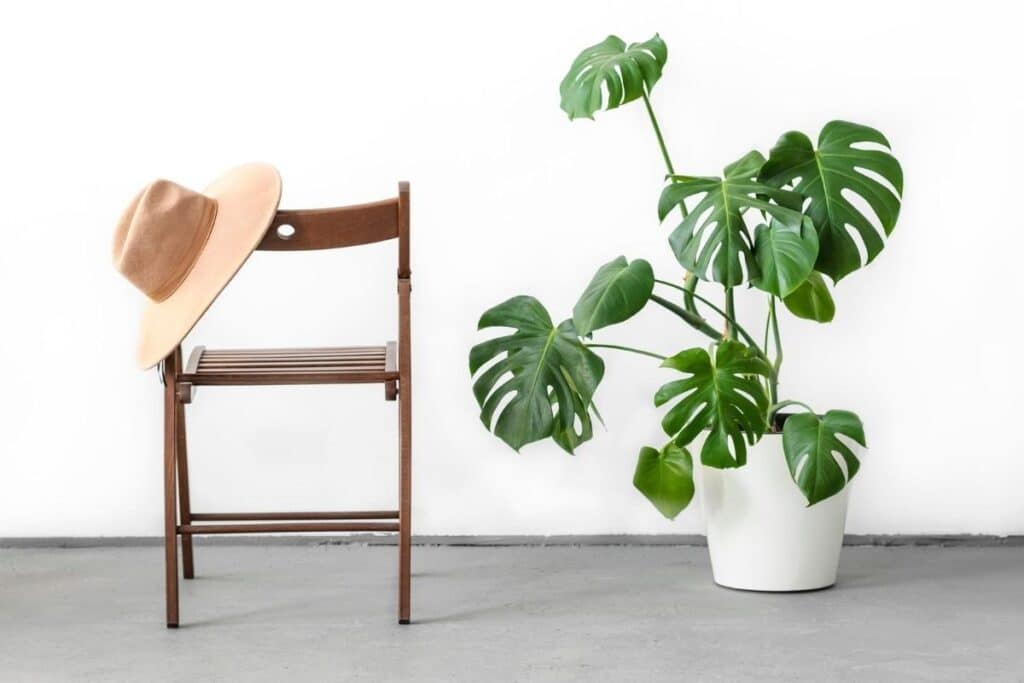
This amusing monstera is commonly known as Swiss cheese plant referring to the natural fenestrations on the heart-shaped leaves that look like the holes on a slice of Swiss cheese. It makes a good specimen plant and is often a conversation piece indoors.
Like most monsteras, the Swiss cheese plant produces aerial roots along the stem letting it climb on trees and stalks. It creates a more dramatic effect when allowed to cascade from hanging containers.
Since it originated from the forests of Central and South America, the plant is used to indirect light, making it adapt well indoors. Just make up for the humid condition by misting the plant and keeping the soil moist.
22. Monstera deliciosa
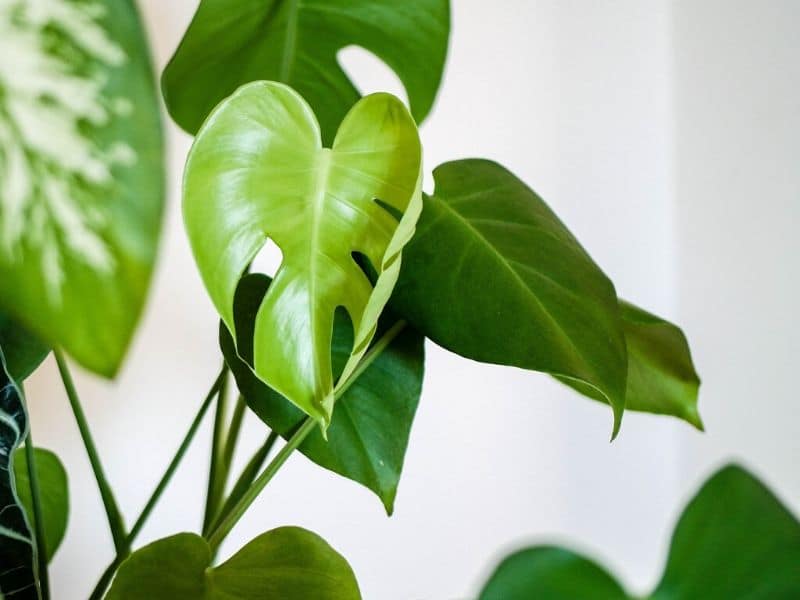
As one of a few tropical plants that can be grown indoors, M. deliciosa is a delightful plant that instantly gives a tropical vibe to any space. The large round green leaves with splits from the margin make the plant unique and gain popularity as a house plant. And it helps that the plant is tolerant of dry air and bright indirect light as well (3).
This monstera tends to have an unruly growth since it naturally grows as a climber on trees in rainforests. It will require stake support as it grows. When the plant has overgrown, the new shoots can be tucked into the container or trimmed with a pair of scissors.
See more: Rhaphidophora Tetrasperma
23. Nephrolepis exaltata
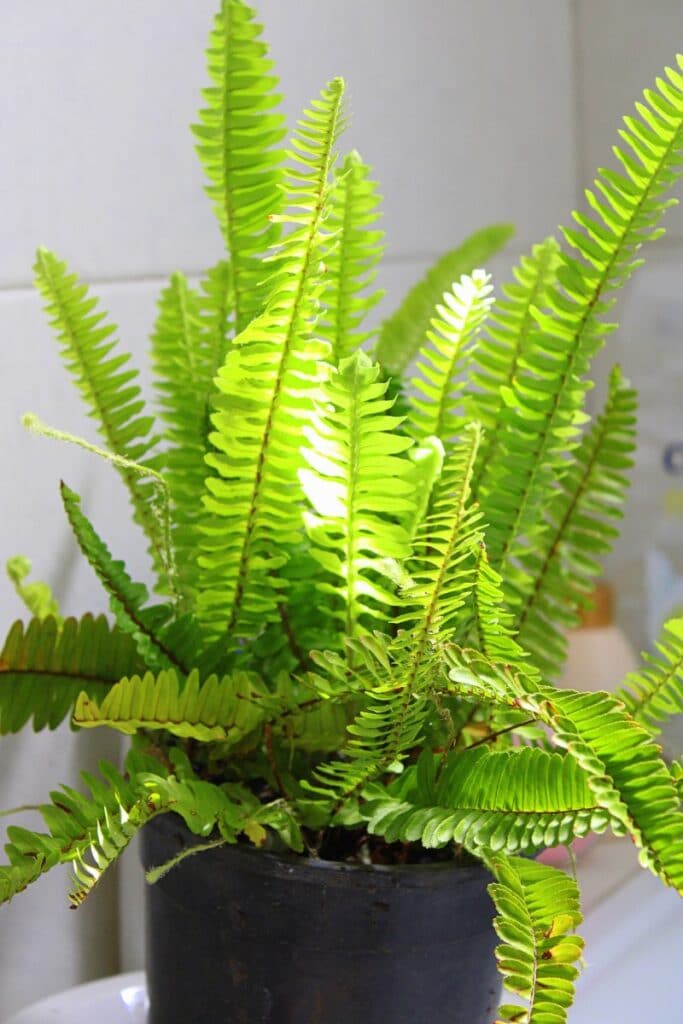
Ferns are known as some of the easiest plants to grow indoors because their natural habitat is not that different from an indoor setting. One of the most popular houseplant ferns is N. exaltata or Boston fern. Its low bushy appearance is due to the fronds or leaves arranged in a feather-like manner that tends to clump together.
At maturity, the growth becomes dense and the fronds droop, creating a dramatic bouquet-like effect. In the wild, it grows on the floors of rainforests so it only requires filtered light. Moisture can be supplied through watering but avoid overwatering to keep the plant from decaying.
24. Oxalis triangularis
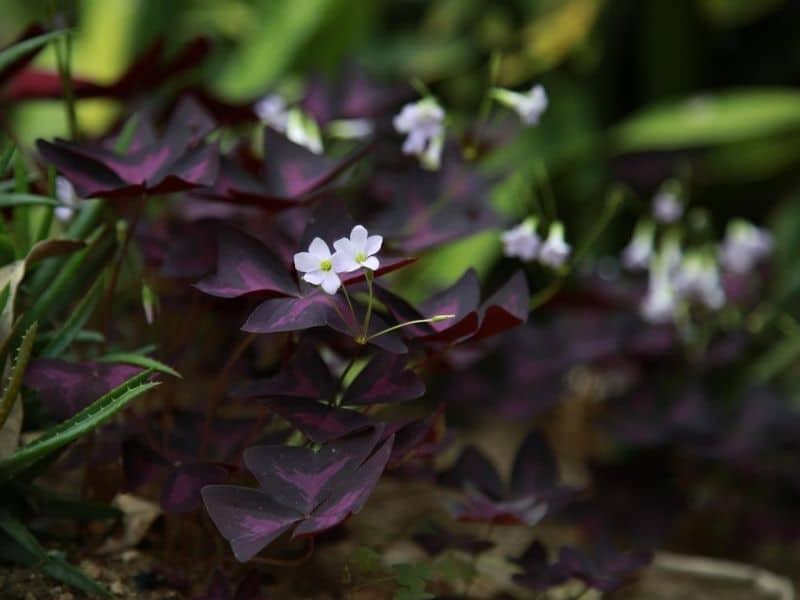
This houseplant is otherwise known as butterfly plant or False Shamrock because the triangular deep purple leaves look like wings in mid-flight. The foliage is striking which makes up for the long period when the plant’s dainty flowers have not appeared yet. When in bloom, the clusters of small purplish-white flowers look striking against the dark-colored foliage.
Given ample exposure to sunlight, the plant will thrive for years, even decades and is one of the top plants’ beginners can easily grow. Butterfly plants require light watering every one to two weeks. In summer, the plant may grow dormant indoors and lose its leaves. Stop watering until the soil is dry and in a few weeks, new leaves will emerge.
25. Phalaenopsis
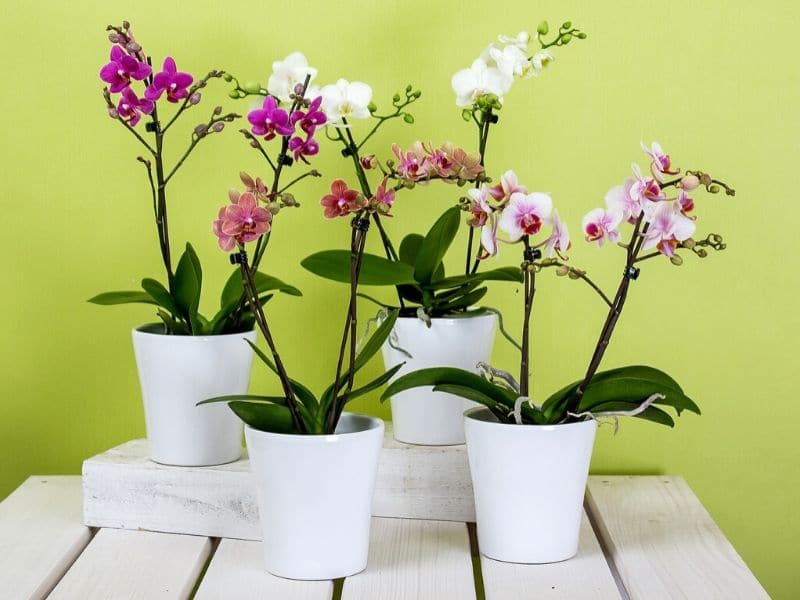
Phalaenopsis is one of the few house plants that showcases spectacular long-lasting flowers. It is also called moth orchid because each one of the cascading flowers looks like a moth with its wings spread open. It is often seen in lobbies of hotels and office reception areas and can be quite an expensive plant.
Like other common types of orchid, moth orchid adapts to the indoor environment well. It thrives in dappled or low light areas, so avoid direct light because it will burn the leaves. Since it is often grown in airy media like moss and bark, watering can be done once a week. After flowering, the plant looks rather dull with only a few wide glossy basal leaves remaining. It will take about a year before the plant produces new flowers on its own (3).
26. Philodendron selloum

P. selloum bears large showy leaves with deep serrations. It brings a dramatic foliage show which makes it a trendy indoor plant. A single plant produces many leaf stalks and when the big leaves roll open, they weigh down the plant and give it an attractive airy spread.
Place selloum in a well-it condition for optimum growth. As the plant grows, it will eventually show a trunk and it will turn leggy if the plant is kept in shade for too long. The soil component should have good drainage to avoid waterlogging and root rot.
27. Rhapis excelsa
Many palms grow well in the indoor setting and one of them is R. excelsa, otherwise known as lady palm. Its defining characteristic is the split fan-like dark green fronds growing from a hairy brown trunk. Some hybrids have white variegations on the leaves. Planted en masse, the plant gives off a tropical vibe while it looks elegant when individually potted and placed indoors.
Dappled light is your friend when growing lady palms inside the house. Direct sunlight will scorch the leaf. Maintain humidity by misting the plant a few times a week, especially when placed in an area with dry air. It tolerates drought but it is ideal to keep the soil moist (3).
28. Saintpaulia
A native to the tropical areas of Africa, saintpaulia or African violet, one of the popular African flowers, has become a common houseplant for it can survive under partial shade. However, to be rewarded with colorful blooms that match perfectly with its waxy deep green leaves, you will need to give it indirect sunlight a few times a week (5).
African violets also bloom when its root system can breathe so best to repot the plant as necessary. Check the bottom of the pot, when root tips are protruding from the potholes, that’s the time to transfer them into bigger containers.
29. Sansevieria trifasciata
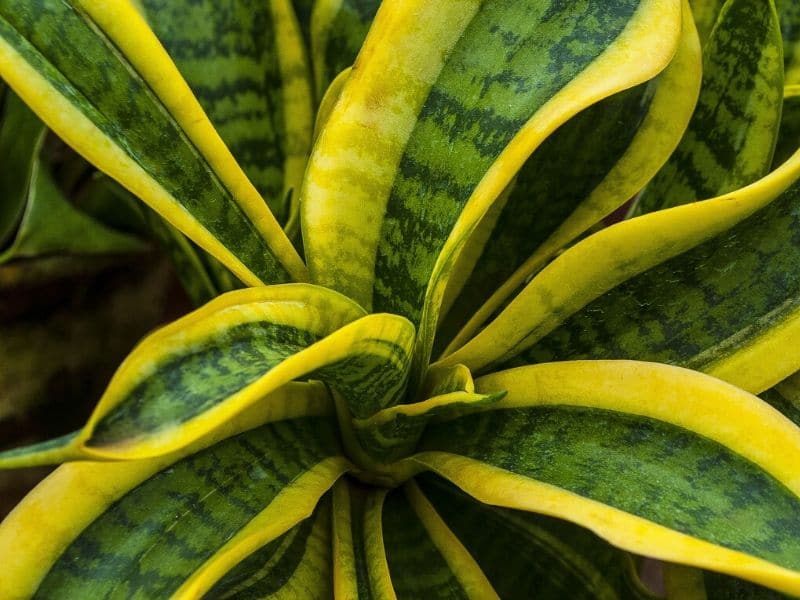
Also called snake plant in reference to its long upright pointed leaves, Sansevieria trifasciata is one of the toughest indoor plants. Many species and varieties now exist in different shapes and forms and shades of green, yellow, and black.
Snake plants are easy to propagate and grow but one species called S. rorida is rare and slow-growing and is considered to be the most expensive one, costing about USD 20,000!
The common snake plant is very versatile. It will need indirect sunlight for optimum growth but it can adapt to full sun or shade conditions. Snake plant is also considered a succulent, able to store water for a long period of time so watering may not be as frequent. It is easy to propagate too, just take a cutting from a healthy leaf and bury it in a well-draining soil (5).
30. Sedum morganianum
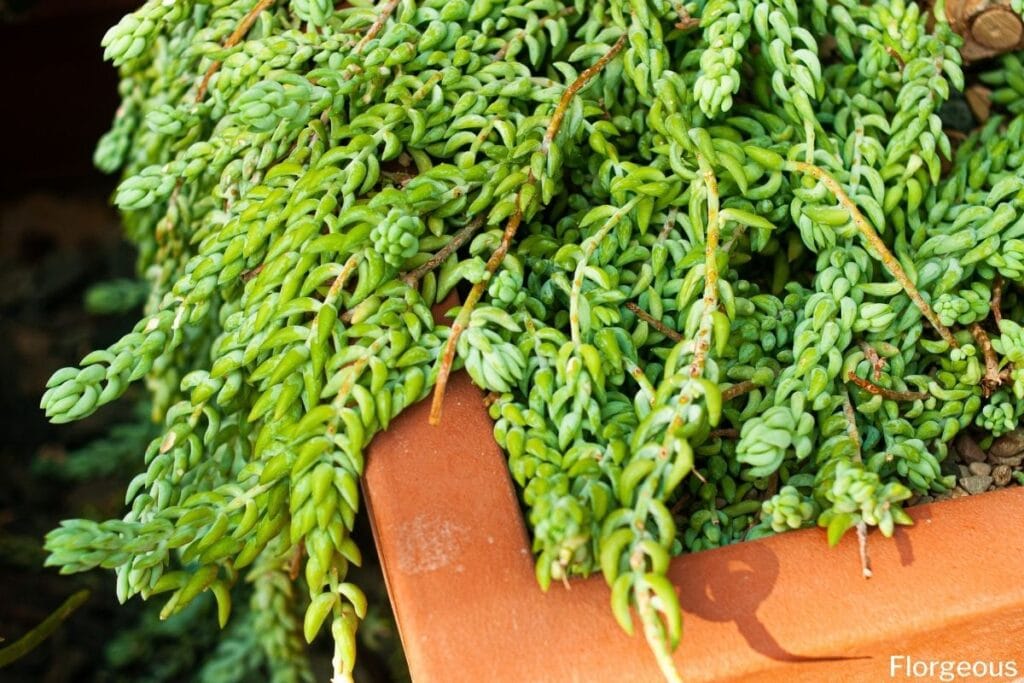
Succulents have become more popular indoor plants in recent years due to their unusual beauty and ease of caring that appeal to modern gardeners.
S. morganianum (Burro’s-tail or donkey’s tail plant) is worth considering because of its draping appearance that will surely catch the attention of your house guests.
Morning light is best for this succulent so place it by east facing windows. When light is insufficient, the plant tends to grow pale and its stubby bean-like leaves start to fall off. Donkey’s tail plant only needs to be watered when the soil surface is completely dry since over-watering will surely kill the plant (3).
31. Senecio rowleyanus

S. reowleyanus is a unique succulent that produces a series of round pea-like “pearls” or leaves along a long slender “string” or stem hence the colloquial name string of pearls. An exotic-looking succulent, it makes an indoor space more attractive and interesting with its trailing growth habit (5).
String of pearls is a vigorous grower and quickly grows long and bushy given the right indoor environment. It is heat and drought tolerant so you can leave it unwatered for weeks, just place it in a fully lit room. These trailing plants are perfect in hanging baskets and terrariums featuring a rock garden.
32. Spathiphyllum

Spathiphyllum or peace lily is a fool-proof indoor plant thriving with minimal attention. The main feature of the plant is the set of large glossy dark green leaves that keeps its beauty even in the dark (1).
White cup-shaped spathe nestling the elongated florets called spadix will bloom periodically but mostly during summer. Applying slow-release complete fertilizer will enhance flowering. The waxy foliage of the plant accumulates dust over time. Wiping the leaves at least once a week with neem oil will keep the plant healthy and pest-free.
33. Thiudium, Fern moss
Growing moss as a houseplant is becoming more popular as it takes very little space and will survive in the indoor setting. In the wild, mosses are found on forest floors or tree trunks so they require little exposure to sunlight. The moist outdoor condition can be mimicked by misting the leaves and keeping their growing medium wet (5).
Thiudium is a species commonly called fern moss that is well suited indoors. It is a simple plant that can be allowed to grow on a shallow pot or for a modern look, on frames hung on walls. Gardeners found them quite effective in terrariums, along with other small plants that like a moist condition.
34. Tillandsia
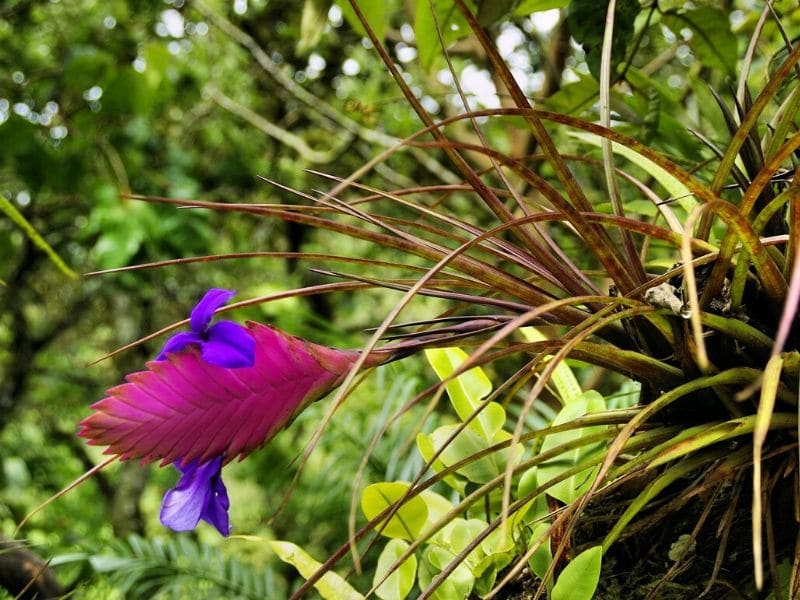
Epiphytes are those that grow without the need for soil or any growing media. They may be the perfect plants for those who prefer soilless gardening or the modern minimalist gardeners.
One of the easiest epiphytes to grow indoors are Tillandsias or air plants (3). Most of them look like thin pineapple leaves without the fruit. Some are dark green, some yellowish, and others are silvery.
Tillandsias have tiny scales on the leaves called trichomes which allow them to absorb water and nutrients from the atmosphere. They can be hung on wire supports or tucked into crevices of driftwoods and shells. Indirect sunlight is best for them and watering should only be in the form of mist.
35. Zamioculcas zamiifolia
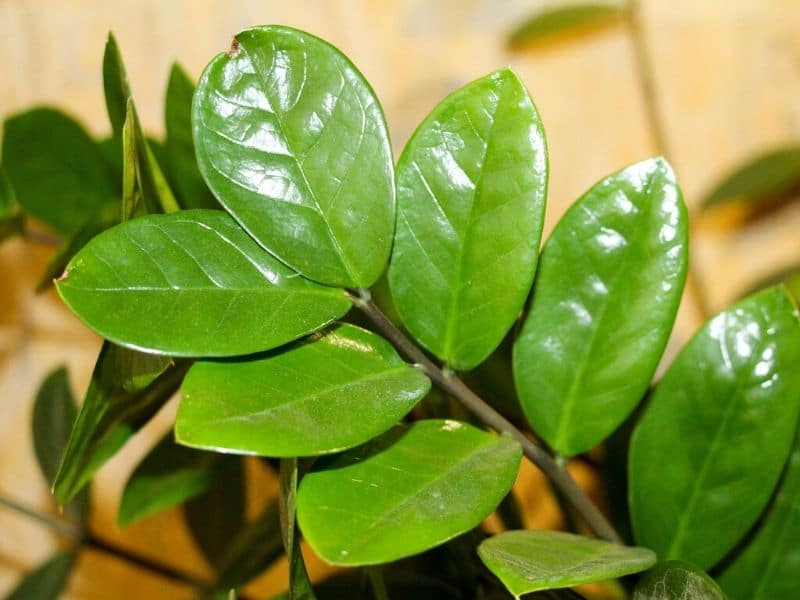
Z. zamiifolia or more commonly ZZ plant is an attractive evergreen with ovate glossy green leaves arranged side by side along thick fleshy stems. A black variety called ZZ ‘Raven’ was recently introduced and became quite popular for its striking foliage.
Potted ZZ plants grow well indoors with either medium to bright light during the growing season. They can also tolerate low light. As long as they have well-draining soil, they do not care much for water. Propagating is done by directly planting the leaves, petiole down. ZZ is a proven air purifier however, it can be toxic when ingested so make sure that it is out of reach of children and pets (5).
36. Aphelandra squarrosa
Aphelandra squarrosa, commonly known as the Zebra Plant, is a striking choice for indoor greenery. With its bold, dark green leaves adorned with contrasting white veins, it adds an artistic touch to any room.
Zebra Plants thrive in moderate light conditions and prefer slightly moist soil. These tropical beauties actively filter indoor air, removing pollutants and enhancing overall air quality.
The unique zebra-like patterns on the leaves make them a conversation starter. They’ll grow faster with proper care, rewarding you with lush foliage. Zebra Plants remain relatively compact, making them ideal for small spaces or tabletops.
Indoor Plant Requirements
There are 3 key factors to consider in growing plants indoors: light, temperature, and humidity (2).
Light requirements
All plants need light to grow and to manufacture food via photosynthesis. Measured in terms of footcandle, the light outdoors ranges from 10,000 ft-c under the bright sun to 250 ft-c under the canopy of a tree.
When bringing plants indoors, it’s crucial to replicate these light conditions or provide enough sunlight as closely as possible, based on the specific needs of your chosen plant. Light sources can come from natural sunlight through windows and other openings in your home, or from artificial lighting options like fluorescent or incandescent bulbs.
Temperature
The second most important factor in plant growth is temperature. It is responsible for the respiration process of plants and the higher the temperature, the faster the respiration is. This process will exhaust the reserves of the plants and if not maintained at the optimum range, the plant will die.
Understanding the temperature requirements of indoor plants is crucial because it helps identify the best indoor location for each specific plant to grow faster.
Relative Humidity
The amount of moisture in the air is determined as the relative humidity. It is found that the best relative humidity for indoor plants should be within 30% to 50% to ensure healthy plant growth. Most indoor plants hail from tropical areas where the relative humidity is high and so this should be made available indoors as much as possible.
Another important requirement for most houseplants is water and many times, the plant dies because of either insufficient or overwatering. Make sure to learn about the water requirements of your chosen house plants to be able to supply the necessary amount.
Overwatering will suffocate the roots and little water halts growth and leaves the plant dry. Light, temperature, and relative humidity must be considered when watering plants because they greatly affect how the plant will absorb the water.
Tools and Materials

If you have decided to go serious in keeping several plants in your home or office or growing house plants as a hobby, it is important to have the basic supplies for you to perform proper plant care. Here are some of the handy gardening tools and materials.
Gloves
Many plants, despite their attractive appearance and ability to cleanse the air we breathe, can be toxic when the sap comes into contact with the skin or when ingested. It is important to wear rubber hand gloves (or cotton gloves when dealing with spiny plants) as protection from possible harm from your beloved plants.
Hand fork and trowel
The soil or growing media of your house plant will get compacted over time. Loosening the soil with a trowel or hand fork will aerate the soil and allow the roots to breathe. The trowel is also handy when propagating or replanting.
Pruning shear
When indoor plants have overgrown or had unwanted growth, they should be trimmed or pruned. The cuts made should be clean and straight so that these openings will not turn into infection sites. Pruning shear is useful in making the proper cuts.
Watering can
Since indoor plants are contained or potted, watering should be monitored and regulated. A handy watering can allow for mess-free indoor irrigation. Some modern systems make use of concealable small hoses connected to a water source and a device for automated irrigation.
Water or moisture meter
Beginners can benefit from using a water meter to identify the best time to water the plant. A water meter device is usually inserted into the soil near the base of the plant to detect the moisture content. It normally has a bar or monitor that indicates if it is time to apply water and if it is enough.
Plant stand
To avoid unnecessary markings or stains on your floor, table or countertop, plant stands can be used. They can also elevate the plant for better air circulation and a wider stand allows you to place all your plants in one area and move them easily inside or outside your home.
Pots and containers
Pots and containers are some of the important considerations in maintaining an indoor potted plant or garden. There are different types of pots and containers like concrete, terra cotta, plastic, etc. that can provide different growth conditions for the plants. For example, terra cottas drain better compared to plastic pots.
Fertilizer
Fertilizers for outdoor gardens can be used for indoor plants too. However, the application is in moderation since the plants are contained and may experience fertilizer burn if over-fertilized. There are slow-release fertilizers available in the market which, as the name suggests, gradually feed the plant over a longer period of time.
Potting mix
When it comes to soil for indoor plants, potting mix serves as the medium that holds the roots of the plants as well as the nutrients and moisture. Depending on the requirement of the plant, potting mixes can be loose, clayey, or loamy. Some plants don’t even need soil and require lighter materials like coconut husks, sphagnum moss, soft bark, etc..
Mulch
Outdoors, mulch materials are known to keep moisture into the soil. However, the indoor setting may be cool and shaded enough that evaporation of water from the potted plant is minimal.
Mulches applied to indoor plants are more decorative to keep the soil and dirt from being blown all over the room. Some mulches include pebbles, dried moss, and processed coconut husks among others.
Neem oil
Neem oil is an organic insecticide that is effective in getting rid of common pests of house plants like aphids, mealy bugs, and spider mites.
Neem extract is a known natural insect repellent and is proven safe to humans, unlike many commercial pesticides. It can be applied to your house plant by spraying the leaves and stems or poured directly onto the soil. Neem oil also keeps the leaves of the plant shiny and attractive.
Seeds and seedlings
Houseplants can be a satisfying hobby and before you know it, you will have more plants than your initial 3 or 4 potted plants. If you want to take this hobby to the next level, a sustainable way of growing plants is from seeds and seedlings. It is even more satisfying to watch your plant grow from seed to a fully grown one under your care.
FAQs
Which plants best for indoor house?
Some popular indoor houseplants include the Snake Plant (Sansevieria), Pothos (Epipremnum aureum), Spider Plant (Chlorophytum comosum), Peace Lily (Spathiphyllum), and ZZ Plant (Zamioculcas zamiifolia). These plants are known for their durability and adaptability to indoor environments.
What is the easiest houseplant to keep alive?
The Snake Plant (Sansevieria) is often considered one of the easiest houseplants to keep alive. It tolerates low light conditions, infrequent watering, and neglect well, making it an ideal choice for beginners or those with limited gardening experience.
Which indoor plant purifies the air the most?
Several indoor plants are known for their air-purifying properties, including the Snake Plant (Sansevieria), Peace Lily (Spathiphyllum), Spider Plant (Chlorophytum comosum), and Boston Fern (Nephrolepis exaltata). These plants are effective at removing toxins such as formaldehyde, benzene, and xylene from the air, helping to improve indoor air quality and create a healthier living environment.
Up Next: A complete list of flowering plants from A to Z.
References
Reference List:
(1) Osterhoudt, M.”Health Benefits of Indoor Plants, Which to Get, and How to Care for Them.” Lulu Press, Inc. 2013.
(2) Pennisi, B. “Growing Indoor Plants with Success.” University of Georgia. 2017. P. 3-7.
(3) Collins, G. “Indoor Plants.” Harper Collins UK. 2005. P. 192.
(4) Van Zile, J. “House Plants for a Healthy Home.” Simon and Schuster. 2018. P. 128.
(5) Martin, T. “The Indestructible HousePlant.” Timber Press. 2015. P. 288.
Close

